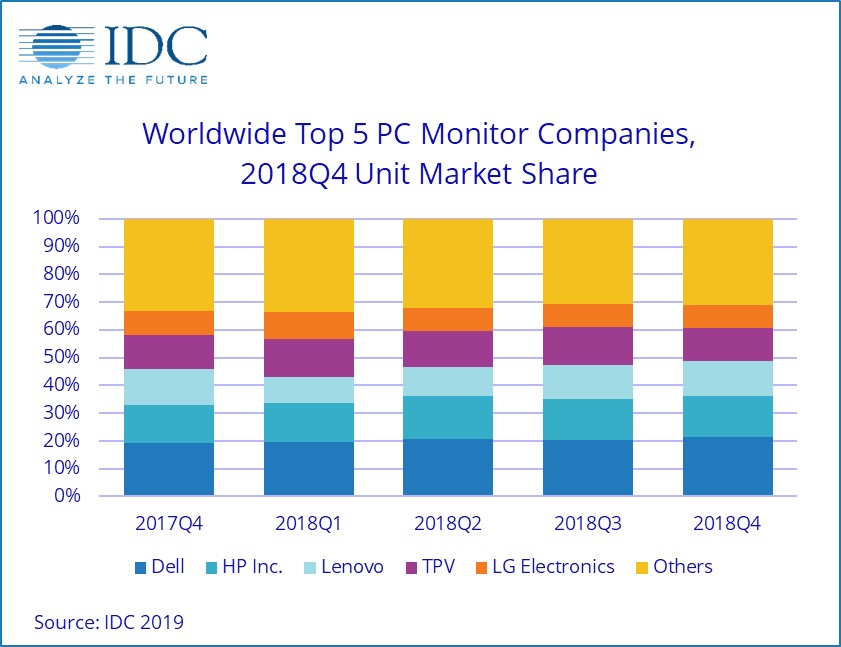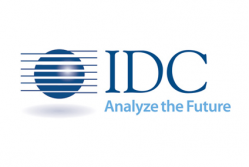The worldwide market for traditional PCs, inclusive of desktops, notebooks, and workstations, declined 3.0% year over year in the first quarter of 2019 (1Q19), according to preliminary results from International Data Corporation’s (IDC) Worldwide Quarterly Personal Computing Device Tracker.
Global shipments were above expectations, reaching 58.5 million during the quarter.
Although the shortage of Intel processors, mostly at the lower end, remained a factor in seeing a contraction in 1Q19, the market performed better than expected with most regions exceeding forecast. Stronger than expected desktop shipments further boosted volume, coming on the heels of a tough previous quarter, (4Q18), which had lackluster consumer demand and desktop supply issues. Furthermore, more PC brands turned to AMD chips. All of this, combined with firms rounding the last corner on its Windows 10 migration deployments, led to a shift in the market for traditional PCs towards more commercial and premium products.
“Desktop PCs were surprisingly resilient as the commercial segment helped drive a refresh during the quarter,” said Jitesh Ubrani, research manager for IDC’s Mobile Device Trackers. “Capitalizing on this refresh cycle, the top vendors – HP, Lenovo, and Dell – each increased their year-over-year volume and captured additional share in the desktop PC market.”
“The U.S. market saw year-over-year volumes decline in notebooks as consumer demand softened during the quarter, offsetting the modest gains we saw in desktops,” said Tom Mainelli, group vice president for Devices at IDC. “Among the top U.S. PC vendors, only Lenovo saw notebook growth from the same quarter a year ago. It represents a tough start to an important year as the industry marches toward the end of life for Microsoft’s Windows 7.”
Regional Highlights
Asia/Pacific (excluding Japan) (APeJ): The traditional PC market in APeJ posted a single-digit decline, close to IDC’s forecast. Adverse economic conditions, weak consumer demand, and component shortages all had a negative impact on sell-in across the region. The market in India posted a decline on the back of further softness in consumer demand and channel overstock, while elections contributed to a delay in commercial projects. Meanwhile, China came in above expectations as vendors pushed more inventory into the channels despite macroeconomic woes and trade tensions with the United States.
Canada: The traditional PC market in Canada continues to exceed expectations and some of this is driven by improvement in the commercial segment. As a result, retail distribution has eroded somewhat and purchasing has slowly shifted to more commercial-friendly channels, such as dealers, value added resellers, and system integrators.
Europe, Middle East, and Africa (EMEA): The traditional PC market came in negative in 1Q19, its second decline in a row after five quarters of growth. Softness was evident primarily in notebooks as component shortages continued to inhibit available supplies to meet the market demand.
Japan: With the end of support for Windows 7 on the horizon, commercial shipments accelerated and the segment beat previous expectations. However, the consumer segment continued to struggle due to extended replacement cycles and higher smartphone usage.
Latin America: Despite unfavorable macroeconomic conditions in major economies such as Brazil, Mexico, and Argentina during the first quarter of 2019, PC shipments were better than expected. The overall Latin America market declined in the single digits versus the previous forecast of a 13% decline.
USA: Intel CPU shortages continued to pose a production bottleneck for PC makers, making it difficult to meet new demand especially from the business side as the Windows 10 migration continues. Notebooks were particularly hard hit as inventory overhang from the previous quarter coupled with lower consumer interest in new PCs restrained unit volume growth.
Company Highlights
Despite a year-over-year decline of 0.8%, HP Inc. managed to regain the top position with 13.6 million traditional PCs shipped during the quarter. Japan was a particularly strong market for the company as it managed to record high double-digit growth during the quarter, largely due to the end of support for Windows 7.
Lenovo slipped into second place after two quarters in the top position. However, on a global basis the company has maintained a consistent growth trajectory over the course of the past year. During the recent quarter, mature markets such as North America and Japan served as strongholds for the company.
Dell Technologies was in third place and managed to experience the strongest growth during the quarter. Similar to HP and Lenovo, Dell was able to capture a larger share of the desktop market. The vendor had sizable growth in Japan and Western Europe.
Apple saw a slight decline during the quarter with 4.1 million units shipped. Though the company refreshed some of its notebooks recently, the latest models have not been met with the greatest fanfare as reviews point to hardware issues that may affect sales in the coming months.
Acer Group rounded out the top 5 with 6.1% market share during the quarter. Like many others, Acer was challenged by Intel’s shortages though the company was able to sidestep the issue in a few cases by incorporating older CPUs from Intel into its Chromebooks. Both Chrome and gaming remain a focus for the company though the company struggles to maintain traction elsewhere.
|
Top Companies, Worldwide Traditional PC Shipments, Market Share, and Year-Over-Year Growth, Q1 2019 (Preliminary results, shipments are in thousands of units) |
|||||
|
Company |
1Q19 Shipments |
1Q19 Market Share |
1Q18 Shipments |
1Q18 Market Share |
1Q19/1Q18 Growth |
|
1. HP Inc. |
13,580 |
23.2% |
13,688 |
22.7% |
-0.8% |
|
2. Lenovo* |
13,427 |
23.0% |
13,194 |
21.9% |
1.8% |
|
3. Dell Technologies |
10,379 |
17.7% |
10,190 |
16.9% |
1.9% |
|
4. Apple |
4,058 |
6.9% |
4,078 |
6.8% |
-0.5% |
|
5. Acer Group |
3,588 |
6.1% |
4,140 |
6.9% |
-13.3% |
|
Others |
13,451 |
23.0% |
15,013 |
24.9% |
-10.4% |
|
Total |
58,484 |
100.0% |
60,304 |
100.0% |
-3.0% |
|
Lenovo (excluding Fujitsu volume in 1Q18)** |
13,427 |
23.0% |
12,304 |
20.4% |
9.1% |
|
Source: IDC Quarterly Personal Computing Device Tracker, April 10, 2019 |
|||||
Notes:
* Due to the Joint Venture between Lenovo and Fujitsu, data for Lenovo in the top line includes Fujitsu shipment volume for both 1Q19 (854K) and 1Q18 (890K).
** For year-on-year comparison, an extra line has been added below the table to show what Lenovo’s growth would have looked like excluding Fujitsu shipment volume in 1Q18.
• Some IDC estimates prior to financial earnings reports. Data for all companies are reported for calendar periods.
-
Shipments include shipments to distribution channels or end users. OEM sales are counted under the company/brand under which they are sold.
-
Traditional PCs include Desktops, Notebooks, and Workstations and do not include Tablets or x86 Servers. Detachable Tablets and Slate Tablets are part of the Personal Computing Device Tracker but are not addressed in this press release.

IDC’s Worldwide Quarterly Personal Computing Device Tracker gathers detailed market data in over 90 countries. The research includes historical and forecast trend analysis among other data.
For more information, or to subscribe to the research, please contact Kathy Nagamine at 650-350-6423 or [email protected].
About IDC Trackers
IDC Tracker products provide accurate and timely market size, company share, and forecasts for hundreds of technology markets from more than 100 countries around the globe. Using proprietary tools and research processes, IDC’s Trackers are updated on a semiannual, quarterly, and monthly basis. Tracker results are delivered to clients in user-friendly excel deliverables and on-line query tools.
About IDC
International Data Corporation (IDC) is the premier global provider of market intelligence, advisory services, and events for the information technology, telecommunications, and consumer technology markets. With more than 1,100 analysts worldwide, IDC offers global, regional, and local expertise on technology and industry opportunities and trends in over 110 countries. IDC’s analysis and insight helps IT professionals, business executives, and the investment community to make fact-based technology decisions and to achieve their key business objectives. Founded in 1964, IDC is a wholly-owned subsidiary of International Data Group (IDG), the world’s leading media, data and marketing services company that activates and engages the most influential technology buyers. To learn more about IDC, please visit www.idc.com. Follow IDC on Twitter at @IDC and LinkedIn.

